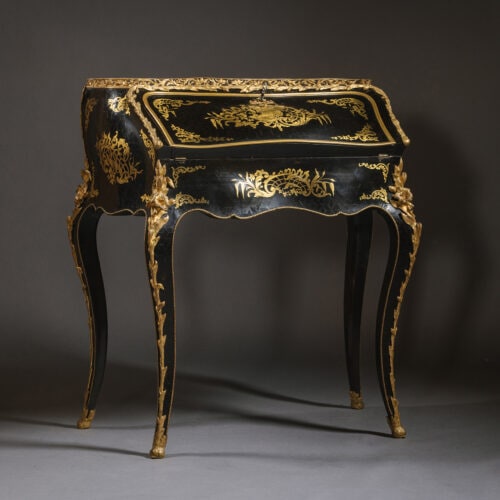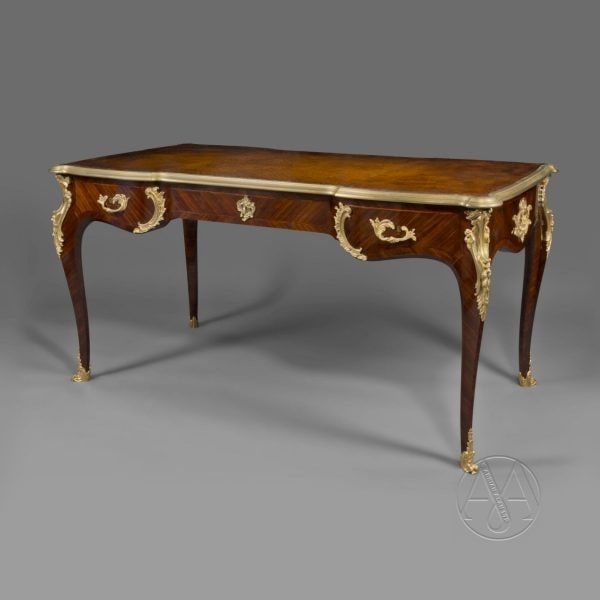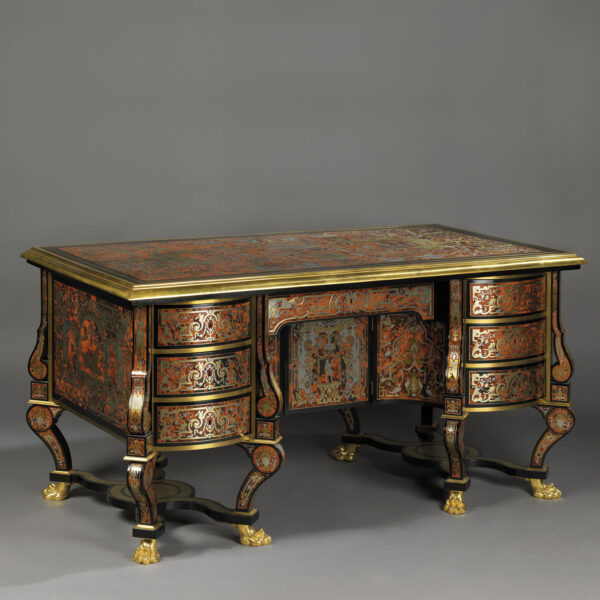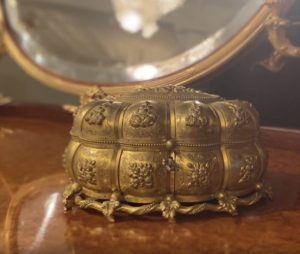Maison Beurdeley
‘Le Bureau Du Roi’
POA
'Le Bureau Du Roi' A Magnificent Exhibition Cylinder Bureau After The Model Supplied to Louis XV by Jean-François Oeben and Jean-Henri...
Dimensions
Height: 145 cm (58 in)Width: 188 cm (75 in)
Depth: 97 cm (39 in)
Description
‘Le Bureau Du Roi’
A Magnificent Exhibition Cylinder Bureau After The Model Supplied to Louis XV by Jean-François Oeben and Jean-Henri Riesener.
By Emmanuel-Alfred (dit Alfred II) Beurdeley (1847-1919), Paris, circa 1890.
The oak carcass with veneers and marquetry of precious timbers. The whole elaborately applied with gilt-bronze mounts. The sides with jasperware plaques by Wedgwood.
The double-dial clock movement inscribed ‘Passement / Hger du Roy / A PARIS’.
The right with marquetry inscribed ‘fait par Riesener / à l’Arsenal 176’
The ormolu mounts variously marked to the reverse ‘BY’ [for Beurdeley].
The jasperware porcelain plaques signed ‘WEDGWOOD’.
The Bureau du Roi or Kings Desk is perhaps the most famous piece of furniture ever made and one of the most luxurious creations of the eighteenth century. The desk was ordered by Louis XV in 1760 from the Royal cabinet maker Jean-François Oeben for his private study and was completed approximately nine years later by Oeben’s successor Jean-Henri Riesener. Adorned with lavish gilt-bronze mounts and remarkable symbolic marquetry, this magnificent cylinder bureau became an icon of Royal absolutism. The breath-taking ambition of the design, combined with its regal history, guaranteed its fame to the present and made its recreation, the zenith of 19th century ébénistes ambitions.
The first replica of this celebrated Bureau du Roi was made in Paris by Carl Dreschler for the 4th Marquess of Hertford between 1853 and 1870 and is now in the Wallace Collection, London. The complexity and fame of the Bureau du Roi led to the finest cabinet makers of the 19th century vying to recreate this spectacular tour de force. An important example was made by Henry Dasson in 1875 and exhibited at the Exposition Universelle of 1878, while Emmanuel Zwiener exhibited his model at the 1889 exhibition. Patrons for such prestigious work included Ludwig II of Bavaria and Russian Tsar Nicholas II.
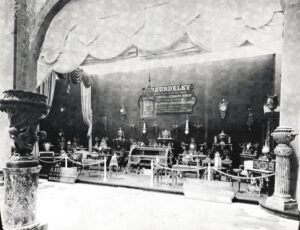
Beurdeley’s stand at the Chicago World’s Fair in 1893. The Bureau du Roi is at the centre of the display.
Beurdeley is recorded to have made a replica of the Bureau du Roi for the 1889 Paris Exposition universelle the same year as Zwiener (C. Mestdagh and P. Lécoules, L’Ameublement d’art français: 1850-1900, Paris, 2010, p.171). The 1889 Beurdeley bureau is inscribed ‘Fait par Riesener à l’Arsenal en 1769, reproduit par Beurdeley en 1889. Paris.’ It was sold in the 6-9 May 1895 Beurdeley sale, Galerie Georges Petit, Paris, lot 277 and bought back by the family, as it is visible in the photograph of the picture gallery at the Beurdeley residence 79, rue de Clichy in circa 1910.
This 1889 dated bureau was subsequently bought by ‘Salar Jung III’ (d. 1949) and is today in the Salar Jung Museum, Hyderabad, India.
The present version, also executed with the exquisite quality associated with Beurdeley’s workshops and marked with the Beurdeley incised cypher ‘BY’ to the reverse of the bronzes, is almost certainly the Bureau du Roi exhibited at the Chicago World’s Fair of 1893.
Beurdeley received substantial commissions for the American titans of the Gilded Age and his increasing popularity with America’s industrialists was underscored by his participation in the Chicago World’s Fair, where the Bureau du Roi was displayed in prime position, centerstage among a large and impressive selection of wares. Beurdeley supplied various objects and furnishings for the renovation of The Cornelius Vanderbilt II Mansion, described as an ‘early French Renaissance style château’, at the northwest corner of West 57th Street and 5th Avenue in New York, including a bronze-mounted marble fire surround exhibited, like the bureau, in Chicago in. Probably under the direction of interior decorator Jules Allard & Fils, Beurdeley executed numerous bronze and marble objects for Cornelius Vanderbilt’s Newport ‘cottage’, The Breakers (see in C. Mestdagh, op. cit., pp. 128-123).
Gilded Age Provenance
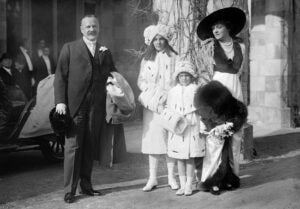
George Jay Gould (1864–1923) and Edith M. Kingdon (1864–1921) and family at the January 22, 1913 wedding of Helen Miller Gould (1868-1938) (courtesy Wikipedia).
The present bureau has its own illustrious provenance tracing it to a no less infamous titan of the Gilded Age. It belonged to George Jay Gould I (1864–1923), the financier and eldest son of Jay Gould, the railroad magnate who is generally identified as one of the Robber barons of the Gilded Age.
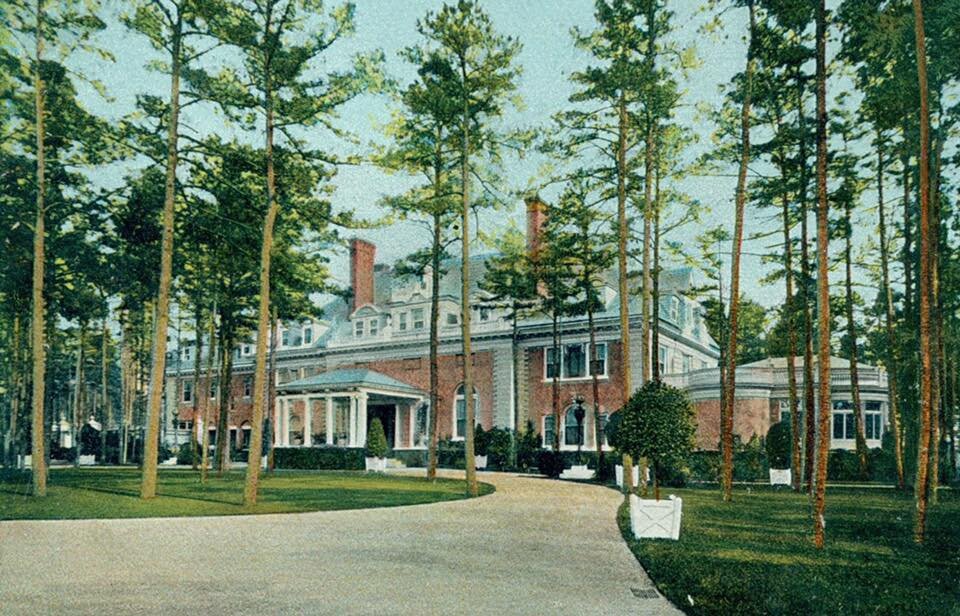
Georgian Court was built by George & Edith Gould as their palatial country estate at Lakewood, New Jersey. Designed by architect, Bruce Price in 1898. The approximately 150-acre estate also had numerous entertainment and sports facilities, including a private golf course adjoining palatial landscaped gardens. The estate is now Georgian Court University.
This bureau is illustrated Georgian Court, the estate Gould built with his wife, the actress Edith Kingdon Gould (1864-1921), in Lakewood, New Jersey.
Jay Gould was a competitor and sometimes business partner of Vanderbilt, and although he died in 1892 a celebrated painting by Jean-Baptiste Camille Corot, entitled ‘Evening’, was loaned to the Chicago World’s Fair of 1893 by ‘the late Jay Gould’ (Official Guide to the World’s Columbian Exposition, Chicago, 1893, p. 63). Undoubtedly, his son George Jay and daughter-in-law would have visited the Chicago World’s Fair where it is probable that they bought this Bureau du Roi from Beurdeley’s stand.
Edith Kingdon Gould was a famous actress in her youth and died in 1921 whilst playing golf at the course of their home at Georgian Court. After which George Jay Gould married his mistress Guinevere Jeanne Sinclair (1885–1978) and moved to London, only to die himself in May 1923 on the French Riviera after contracting a fever in Egypt where he visited the tomb of Tutankhamum. The Bureau du Roi was photographed at Georgian Court and was later sold at auction as part of the collection of the late Edith Kingdon Gould in 1928.
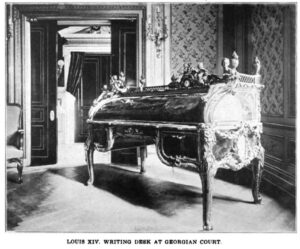
‘Le Bureau Du Roi’ photographed at George Court from The Great American Architects Series, The Architectural Record, ‘The Works of Bruce Price – A Critique by Russell Sturgis’ 1899, p. 98. ‘Louis XIV writing desk at Georgian court’
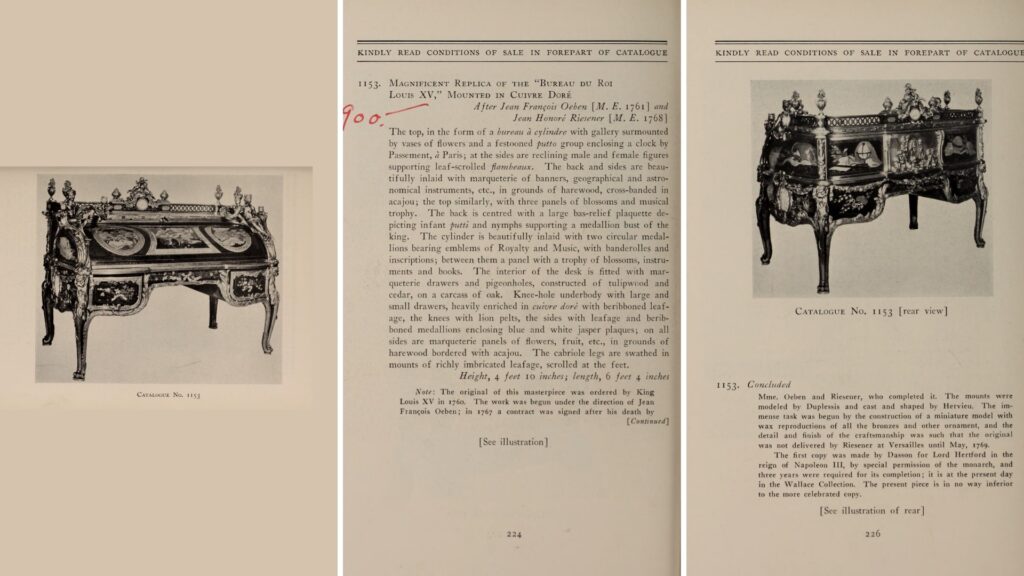
As documented in the 1928 auction catalogue: ‘Artistic Property, Contents of Oldfield House, Red Bank, N. J. Collection Belonging to The estate of the late Edith Kingdon Gould (Mrs. George Jay Gould), Sold by Direction of Jay Gould & Charles Prentiss Noyes Executors’, The American Art Association, New York, 31 March 1928 [Fifth Session], Lot 1153.
The Bureau de Roi

The Bureau du Roi made for King Louis XV was started in 1760 by the master cabinet make Jean-François Oeben and was finished in 1769 by his successor, Jean Henri Riesener, who had married Oeben’s widow. It was made for the new Cabinet du Roi at the Palace of Versailles where it is displayed to this day.
‘Il n’est probablement pas au monde de meuble plus célèbre que le grand Secrétaire à cylindre.’
Pierre Verlet
Without doubt one of the most important pieces of furniture ever made the Bureau du Roi was ordered by Louis XV of France in 1760 for his private study.
The construction of this extraordinary piece was started in 1760 by Jean-François Oeben, and finally delivered to the King in May 1769 after its completion by Oeben’s successor, Jean-Henri Riesener. The desk, which took numerous craftsman nine years of meticulous work to bring it to perfection, dominated Riesener’s work during this period. In addition to the intricate marquetry and finely cast mounts, the roll-top desk mechanism was especially ingenious. It allowed the King to lock all his papers with a single turn of the key while cleverly still permitting servants access to the inkwells through the two side drawers.
The key an object of great beauty in its own right was designed by Riesener with Louis’ double ‘L’ cypher’ and was kept constantly in the pocket of the king. Originally the key had at its centre a small Sèvres porcelain medallion representing the king which was removed following the revolution.
Originally located in Louis XV’s study at Versailles it was moved to the office of Napoléon’s assistant in the Tuileries in an inventory of 1807. It was subsequently moved again to the grand salon at the Palais des Tuileries for a short time until transferred to Saint-Cloud by Empress Eugénie in 1855. In August 1870 it was at the Musée du Louvre before being finally returned to Versailles in 1957.
The desk is further embellished with lavish marquetry with intricate detail depicting science and the arts to the roll top and front of the desk, with the sides further embellished with beautifully cast gilt bronze cornucopia issuing finely inlaid marquetry flowers.
Several alterations to the original design were made by Riesener himself during the post-revolutionary turmoil of 1794, all of which were reflected in subsequent recreations of the desk. He removed the medallion with the king’s effigy around the clock and replaced the intertwined ‘L’s on the side with Sèvres porcelain plaques imitating Wedgwood Jasperware plaques of the Three Graces and replaced the marquetry ‘attributes of Royalty in the centre of the roll-top with scientific instruments.
Date
Circa 1890
Origin
France
Medium
Marquetry and Gilt-Bronze
Signature
The gilt-bronze mounts variously marked to the reverse ‘BY’.
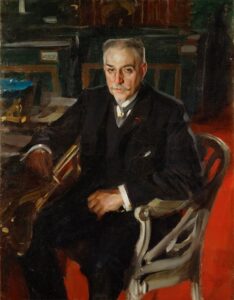
Emmanuel-Alfred (dit Alfred II) Beurdeley (1847-1919)
The Beurdeley family were a flourishing dynasty of three generations of fine quality cabinetmakers working from 1818 to 1895. The firm was particularly well known for its exceptional metalwork, most commonly basing their designs on important eighteenth century examples. Their mercurial gilding and hand chasing are often of such a high standard that it is difficult to distinguish them from late eighteenth century work.
The founder of the dynasty Jean Beurdeley (1772-1853) was a Burgundian craftsman conscripted into the Napoleonic army. After hostilities ended in 1815 he settled in Paris opening a shop for curiosités and working as a latter day marchand mercier. Initially based on the rue Saint-Honoré, in 1840 Beurdeley moved to the famous Hanover Pavilion situated on the corner of rue Louis-Legrand and boulevard des Italiens, and the business was run by his only surviving son, Louis-Auguste-Alfred (1808-1882). This successful business, which had numerous official commissions including in 1853 the marriage coffer for the Empress Eugénie, was continued by Louis’ son, Alfred-Emmanuel-Louis (1847-1919).
The business continued in its traditional style with very few variations until 1895. Alfred, along with the most famous artists of the period, took part in the 1878 Paris Exposition Universelle where he won the gold medal. Following on from this glory, he went on to open a shop in New York.
His participation in the 1883 Amsterdam Universal Exhibition drew even further attention to his work, and possibly as a result he was awarded the Ordre National de la Légion d’Honneur, France’s highest official mark of recognition.
The incredible quality of each generation’s work ranked the firm of Beurdeley as pre-eminent amongst Parisian makers of meubles de luxe.
Bibliography:
Ledoux – Lebard, Denise. Les Ébénistes du XIXe siècle, Les Editions de L’Amateur, (Paris), 1984; pp. 75-82.
Mestdagh, Camille & Lécoules, Pierre. L’Ameublement d’Art Français, 1850-1900, Les Editions de L’Amateur, (Paris), 2010; pp.262-276.
Meyer, Jonathan. Great Exhibitions – London, New York, Paris, Philadelphia, 1851-1900, Antique Collectors’ Club, (Woodbridge, UK), 1984 ; pps. 175, 247, 269, 270, 290, 298.
Almost certainly the ‘Bureau de Roi’ exhibited by Beurdeley at The World’s Columbian Exposition, Chicago, Illinois, 1893.Almost certainly George Jay Gould (1865-1923) and Edith Kingdon Gould (1864 –1921) at Georgian Court, Lakewood, New Jersey, USA, and by descent until sold:‘Artistic Property, Contents of Oldfield House, Red Bank, N. J. Collection Belonging to The estate of the late Edith Kingdon Gould (Mrs. George Jay Gould), Sold by Direction of Jay Gould & Charles Prentiss Noyes Executors’, The American Art Association, New York, 31 March 1928 [Fifth Session], Lot 1153.
By repute Oscar Heineman (1863-1946), 2960 North Lakeshore Drive, Chicago, Illinois.
Private Collection, Chicago.
Archie Earl Amos, Fort Wayne, Indiana, by 1960 and sold to;
Jack and Eileen Feather, Pebble Beach, California, by 1985.
Thence by descent, until sold.
Literature
Great American Architects Series, The Architectural Record, ‘The Works of Bruce Price – A Critique by Russell Sturgis’ 1899, p. 98. ‘LOUIS XIV WRITING DESK AT GEORGIAN COURT’ (illustrated).
Archie Earl Amos, Bureau du Roi Louis XV : “The Desk of King Louis XV”, Fort Wayne, Ind. 1960.
Mestdagh, Camille. L’Ameublement d’Art Français: 1850-1900, Les Editions de l’Amateur, (Paris), 2010; p.76-78.
Comparative Literature:
D. Meyer. Versailles Furniture of the Royal Palace: 17th and 18th Centuries, Vol. I; p. 122-131; and
R. Startmann-Döhler, Jean-François Oeben, p. 76, for illustrations and discussions on the 18th century model circa 1760-1769, by Jean-François Oeben and Jean-Henri Riesener
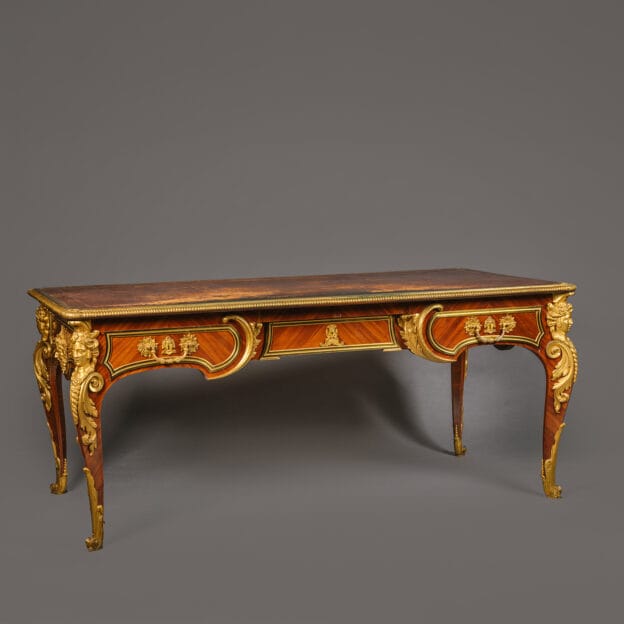
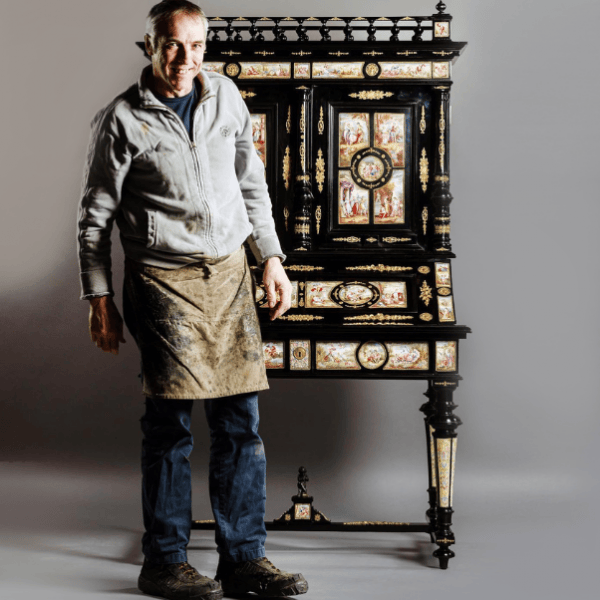
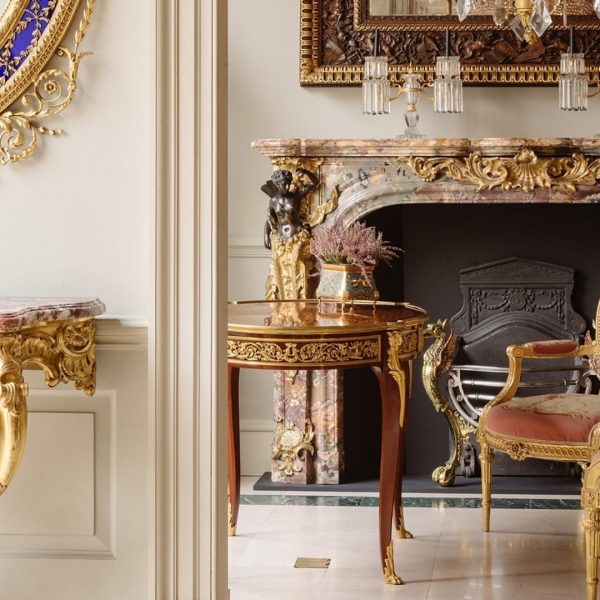
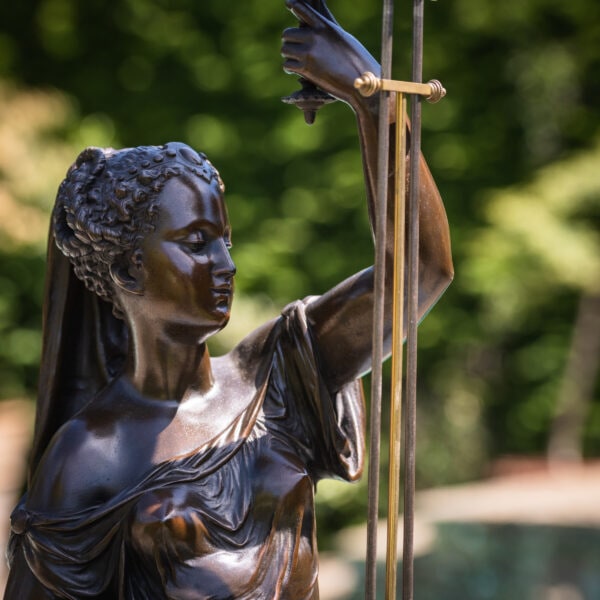
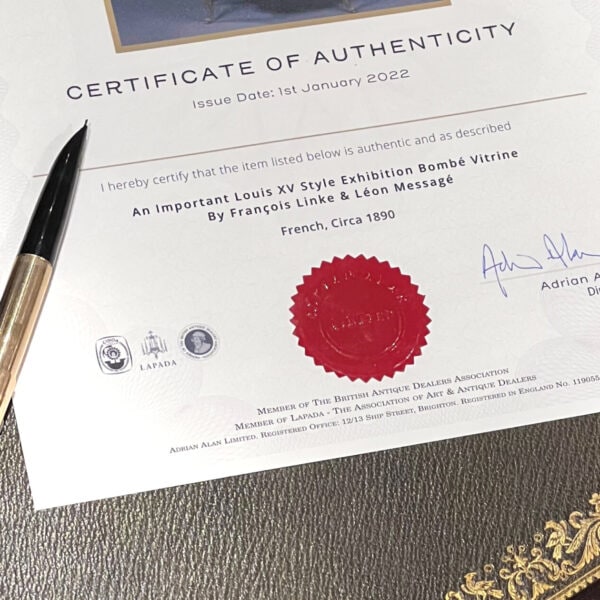
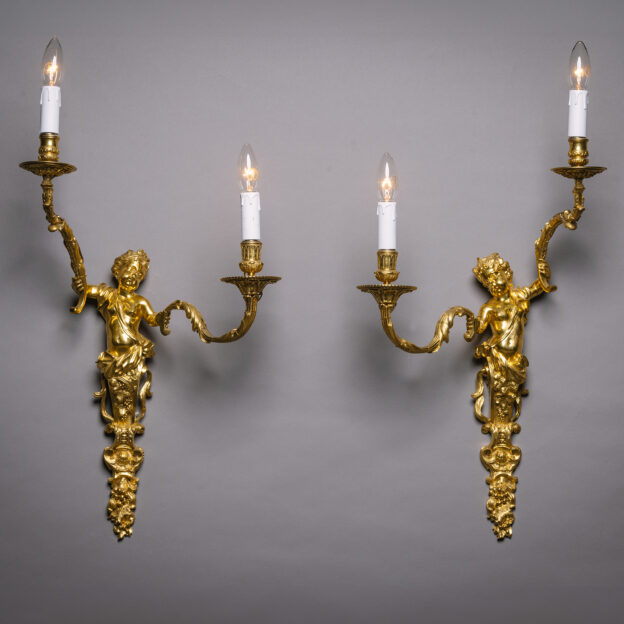
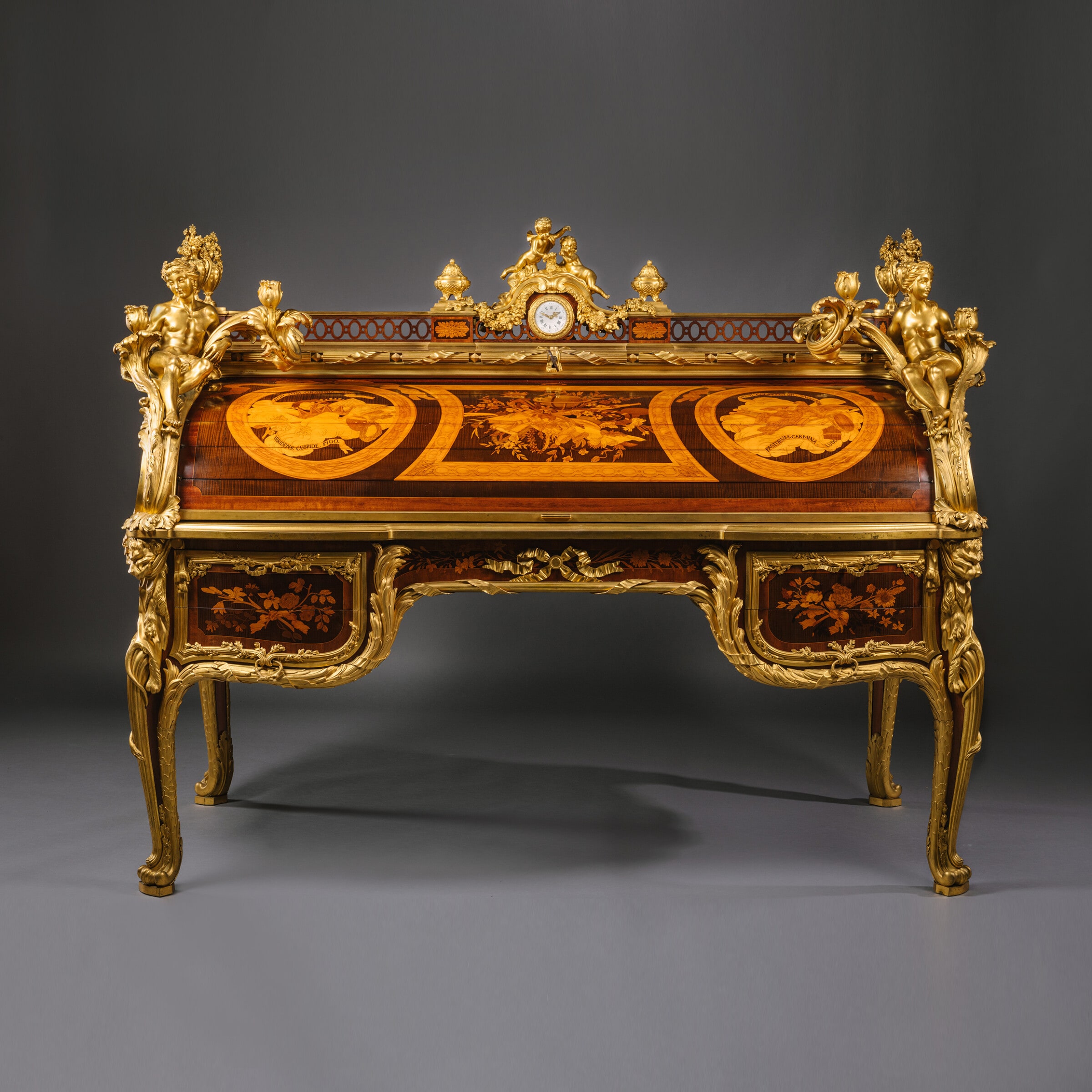
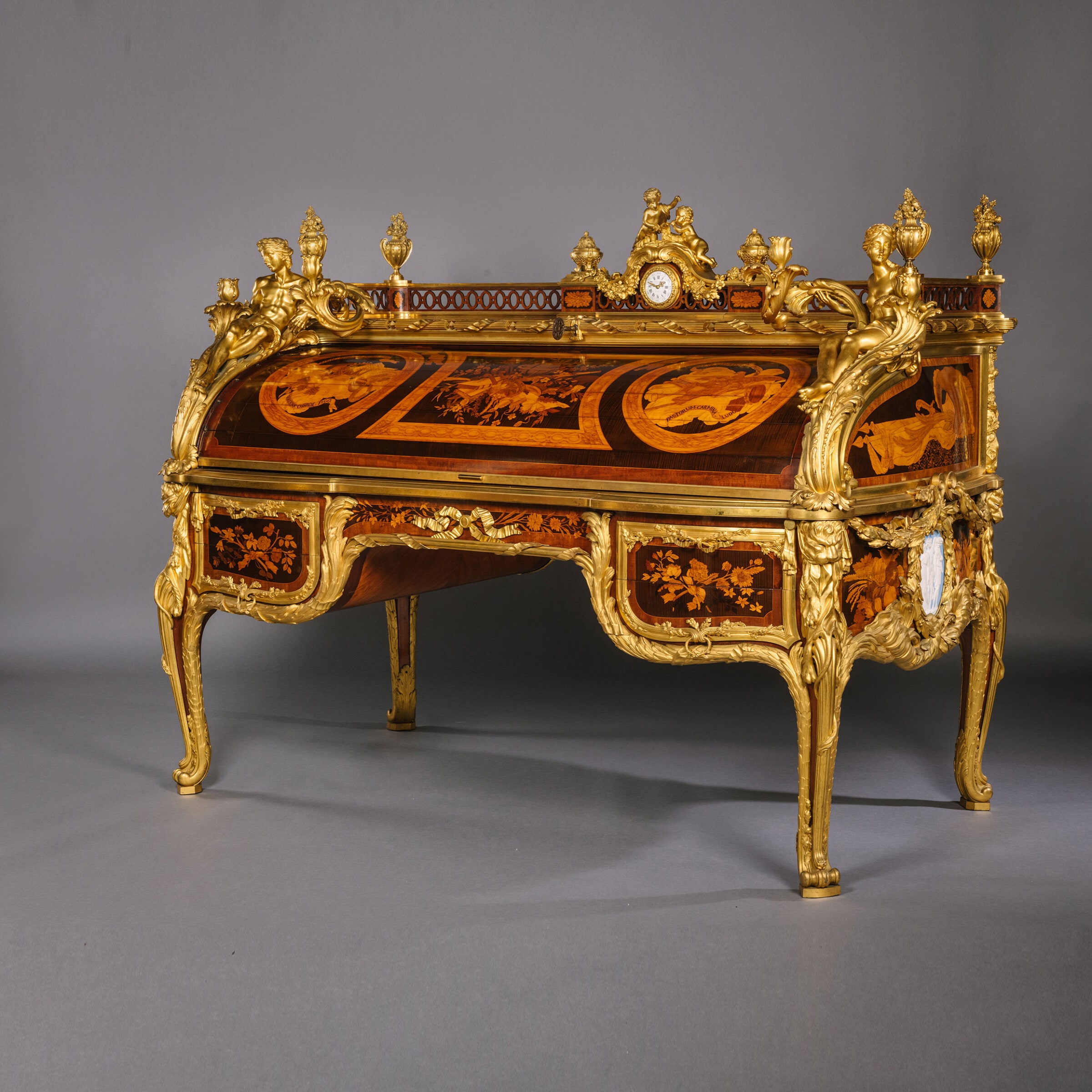
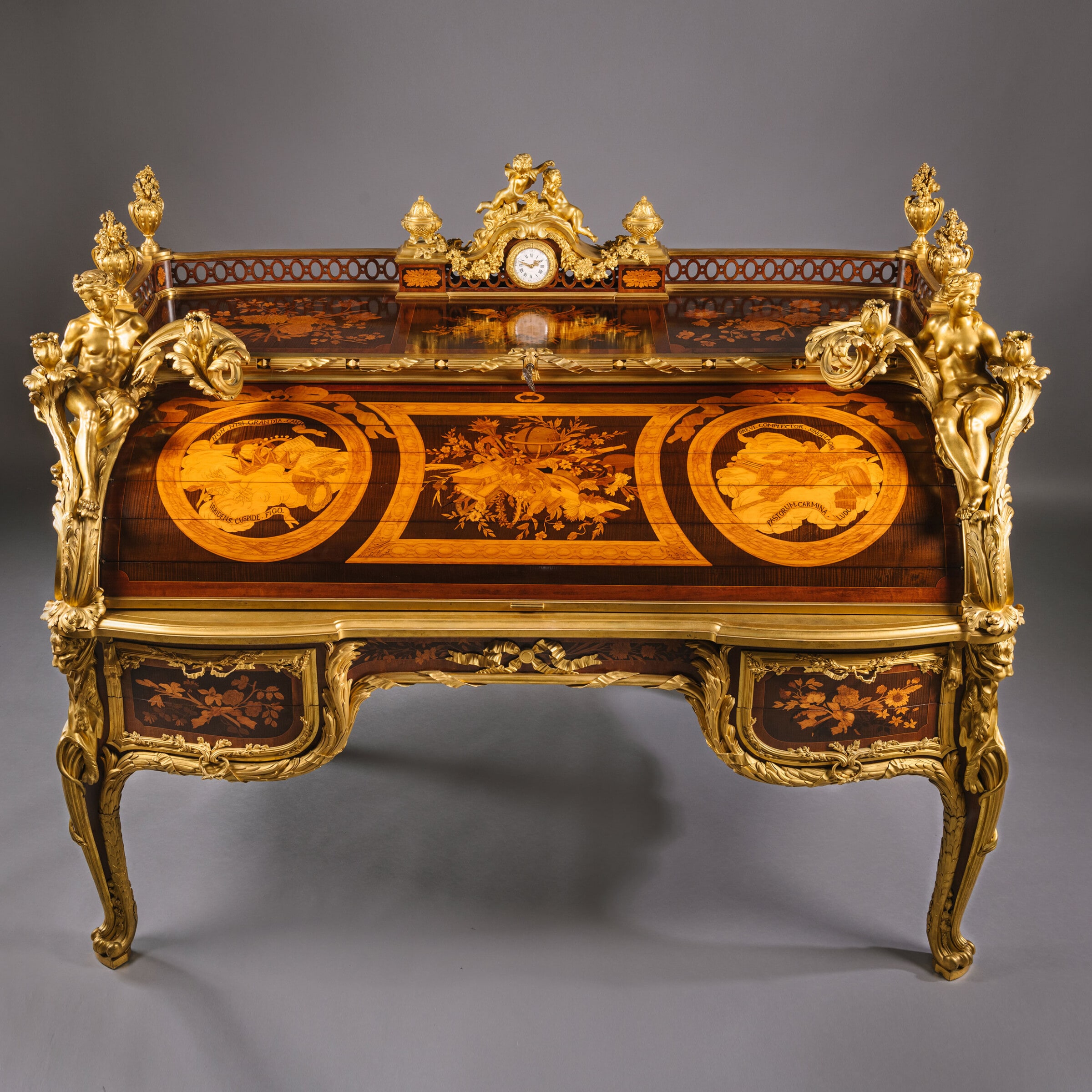
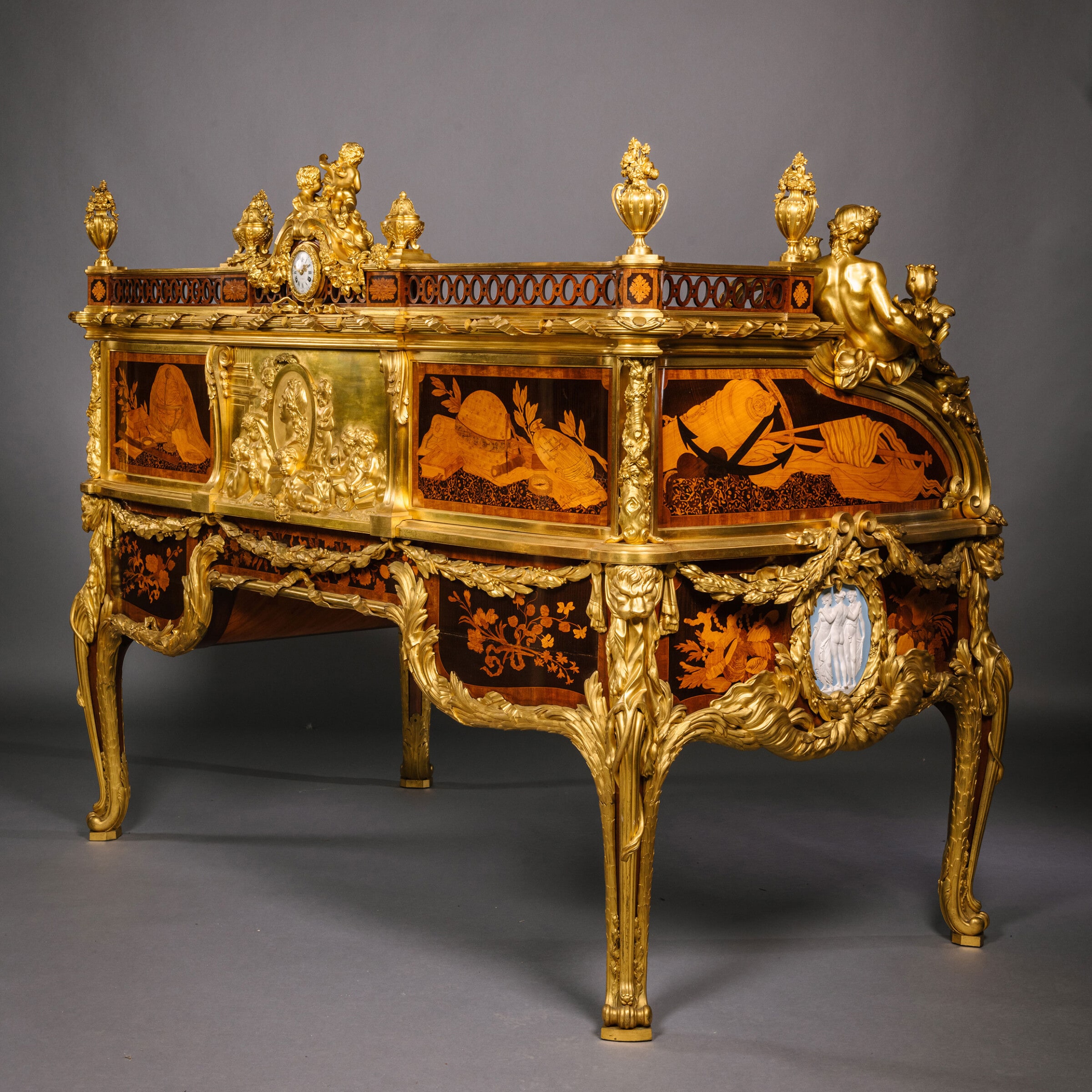
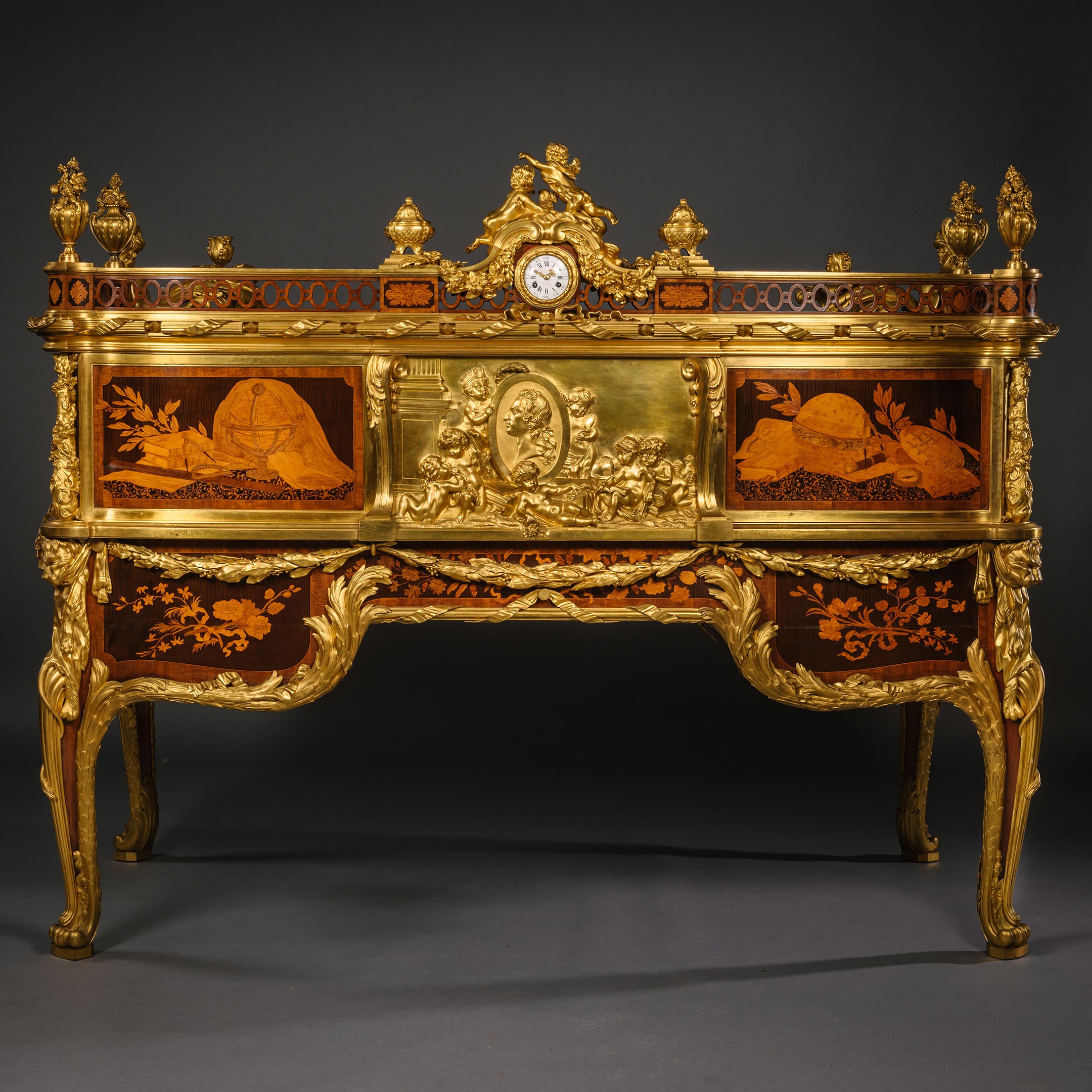
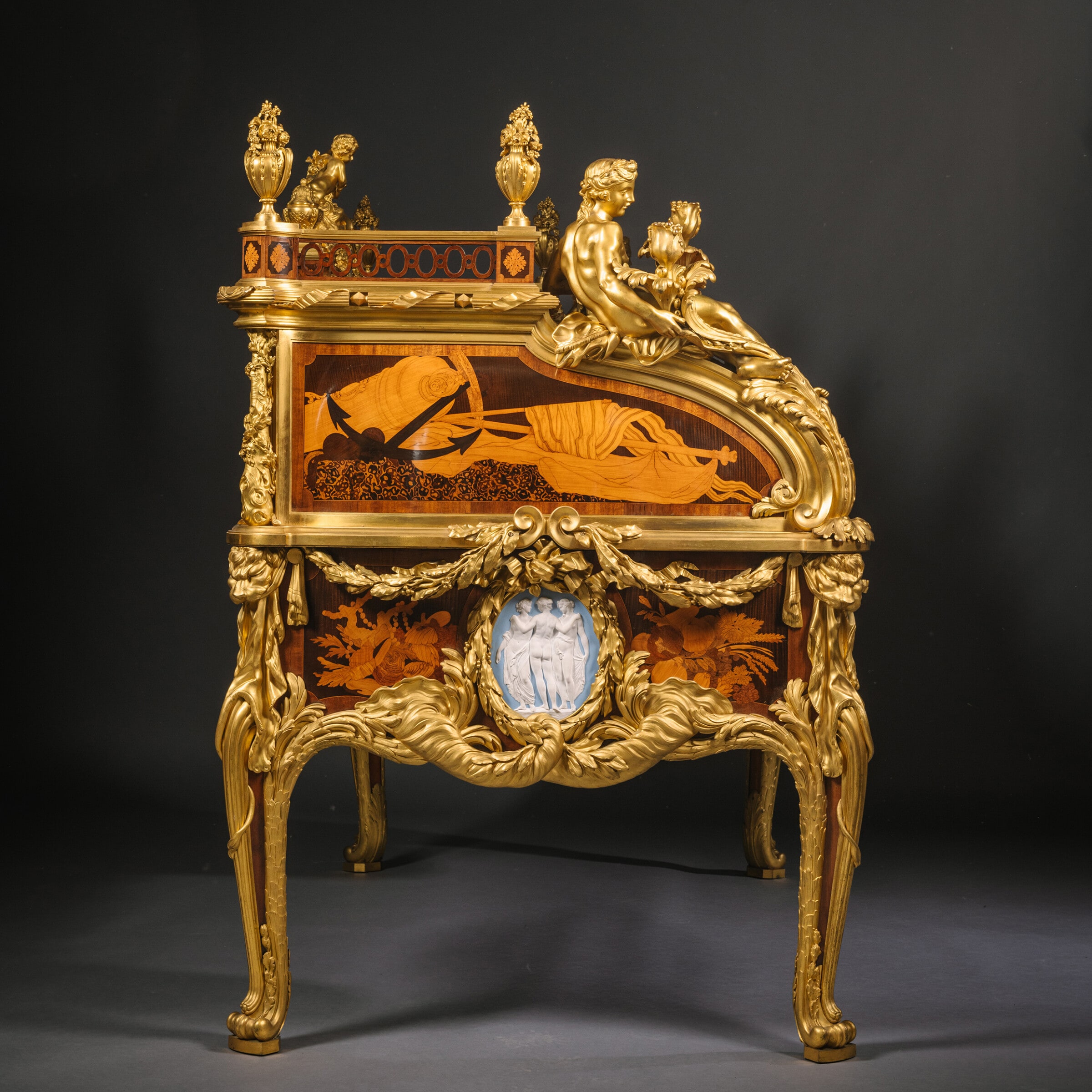
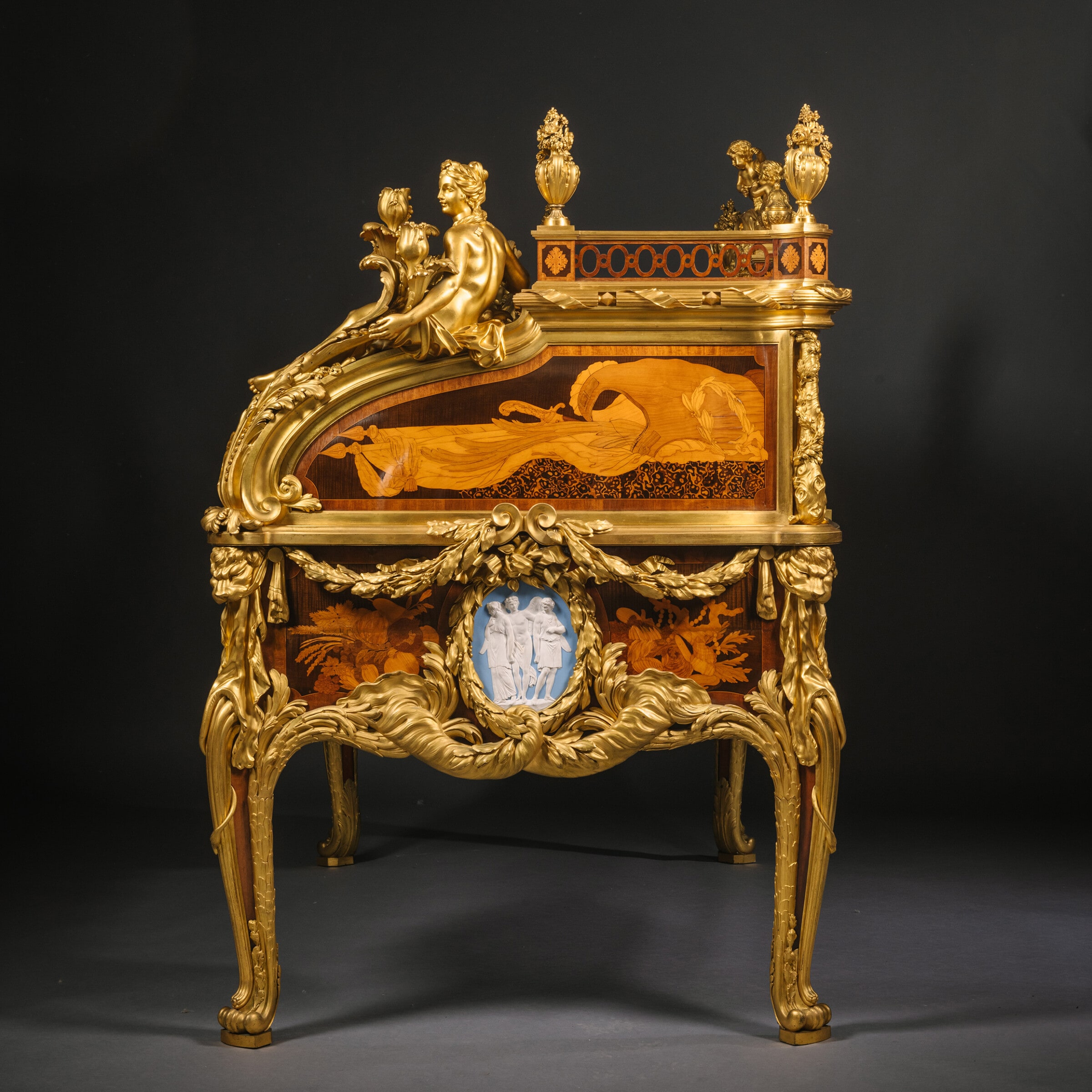
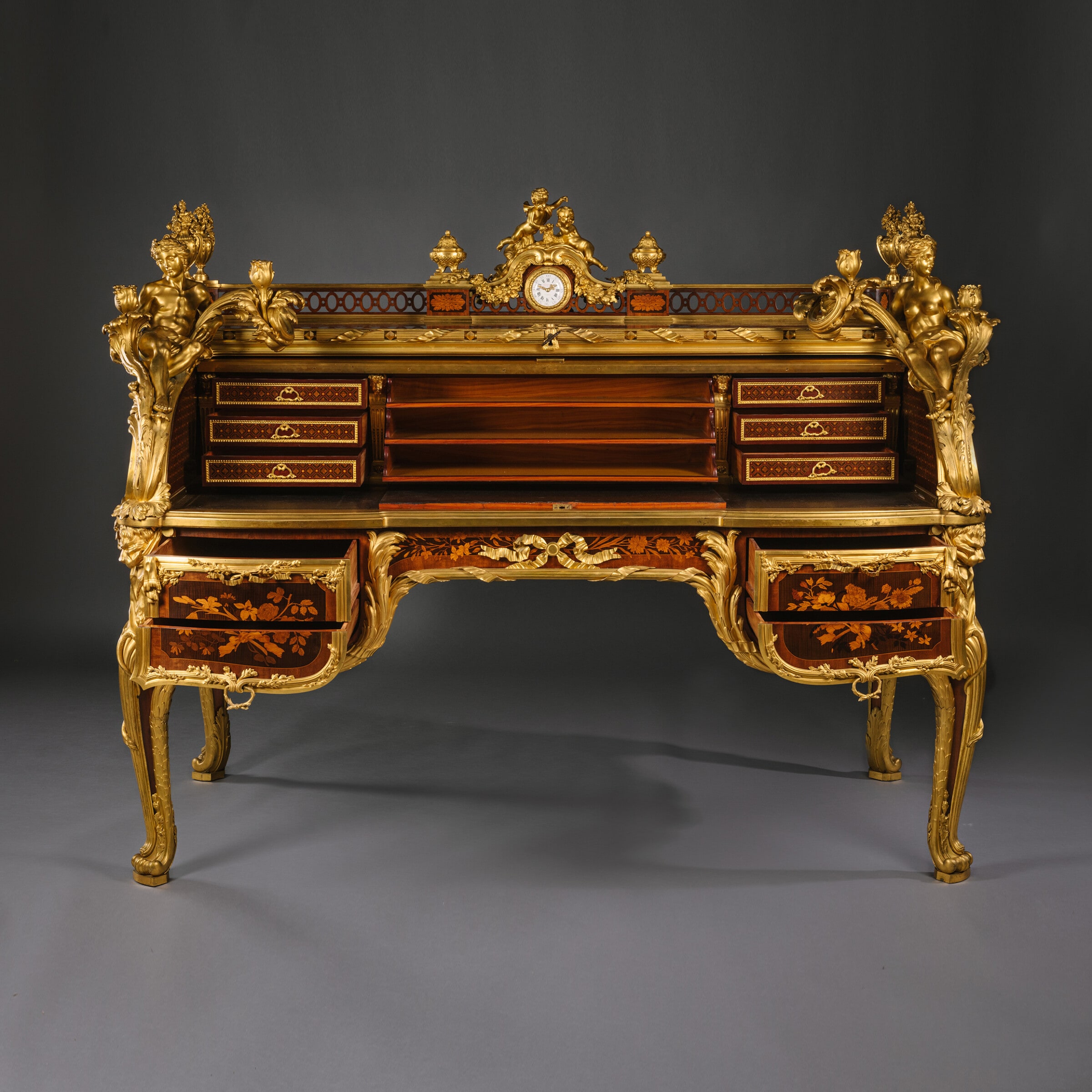

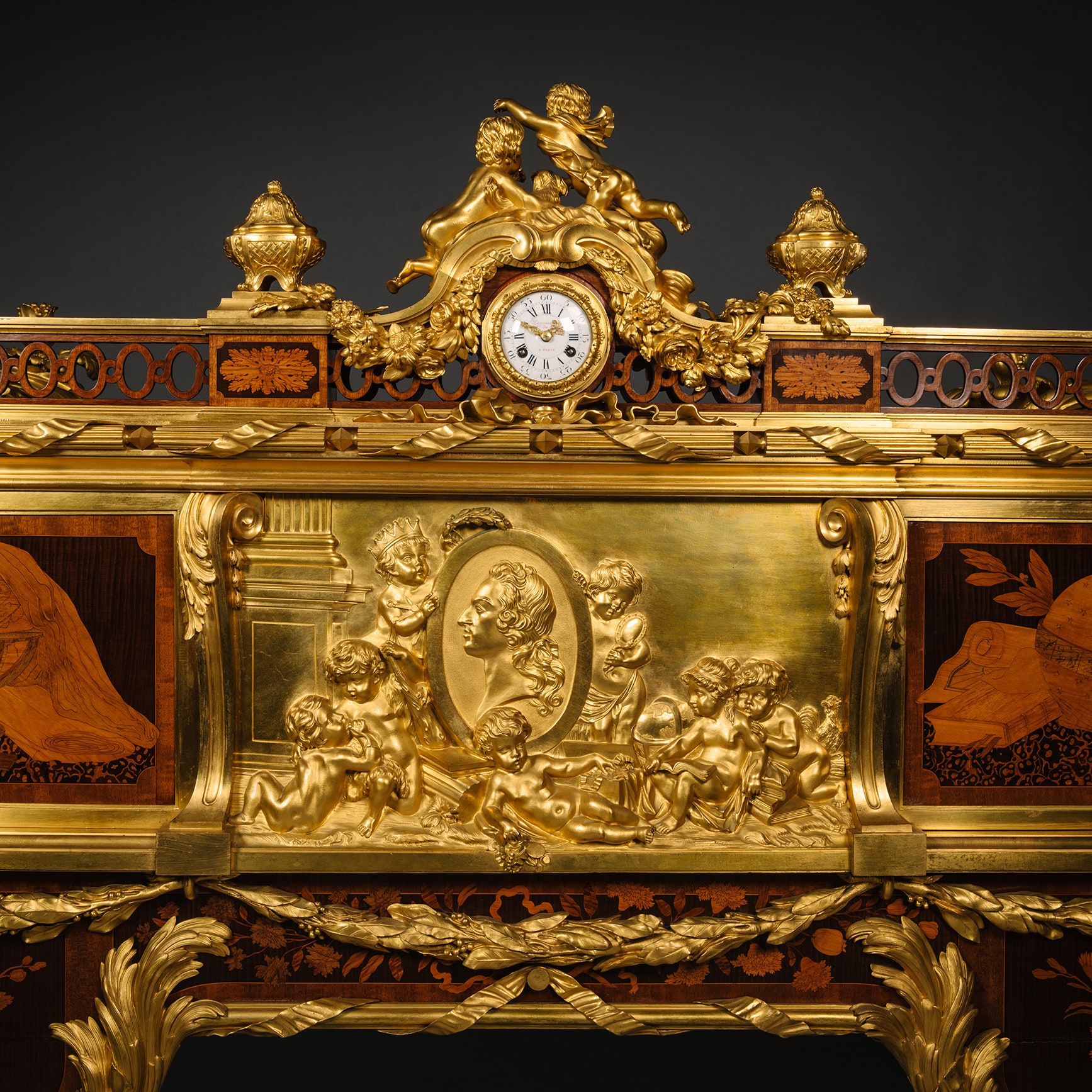

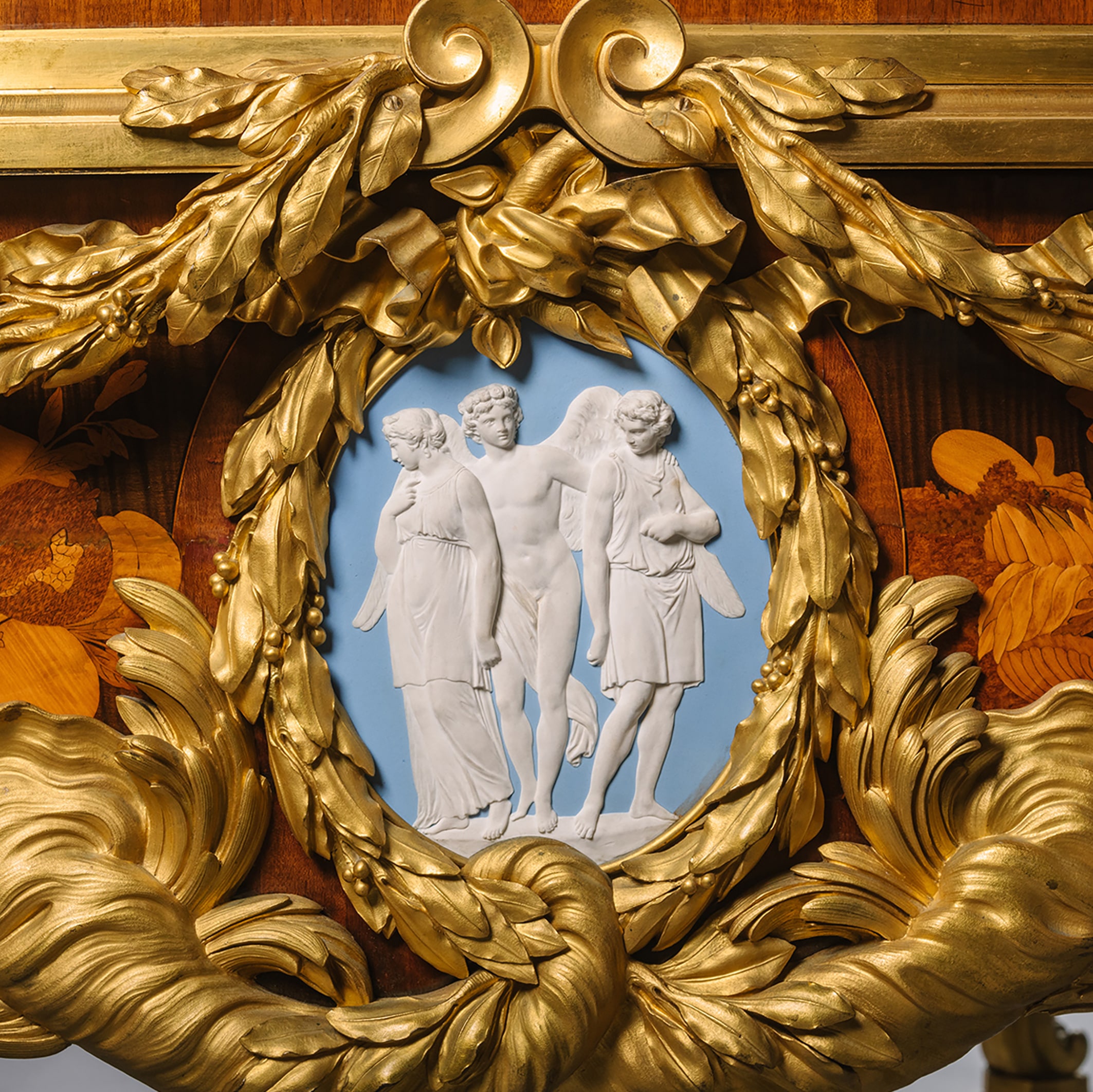
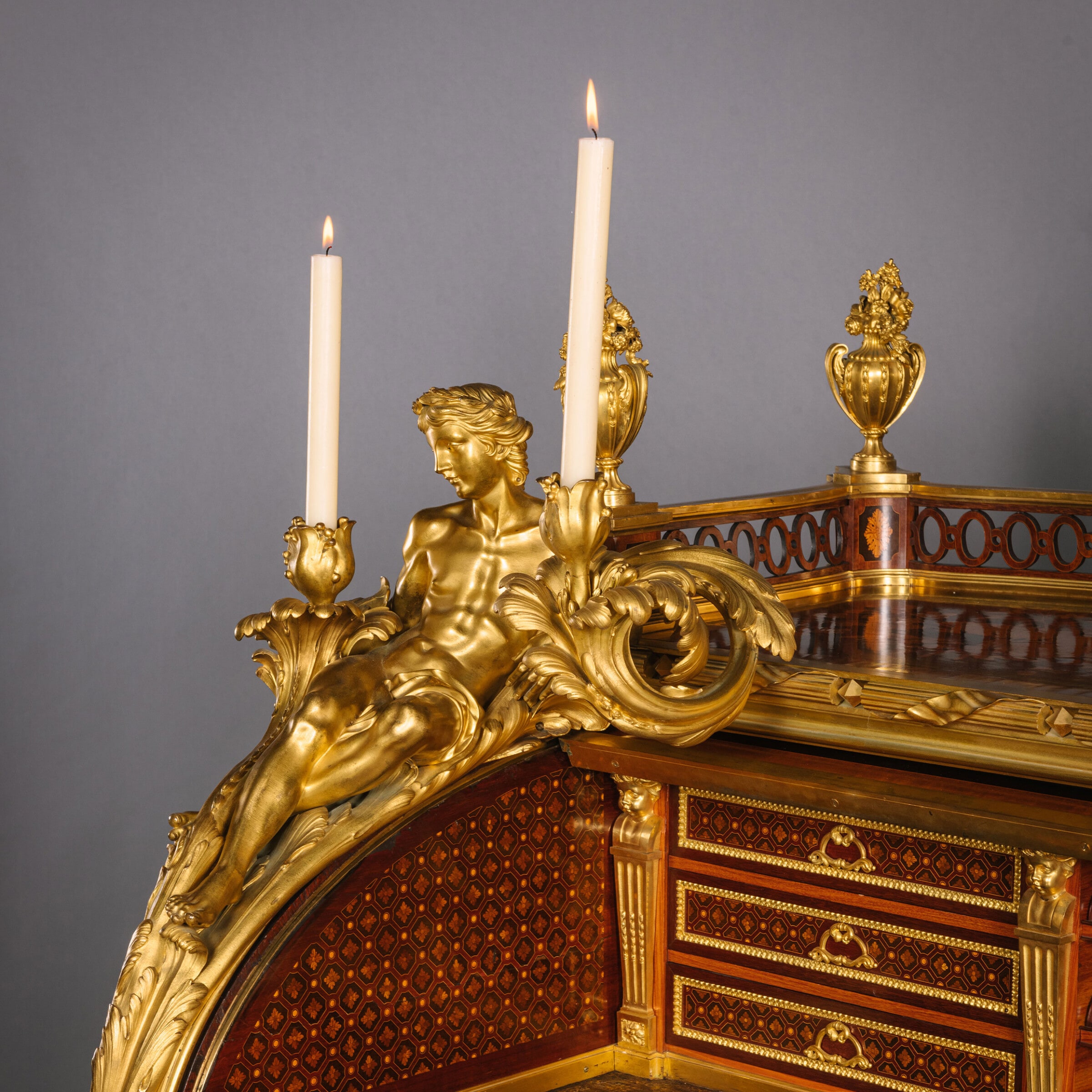
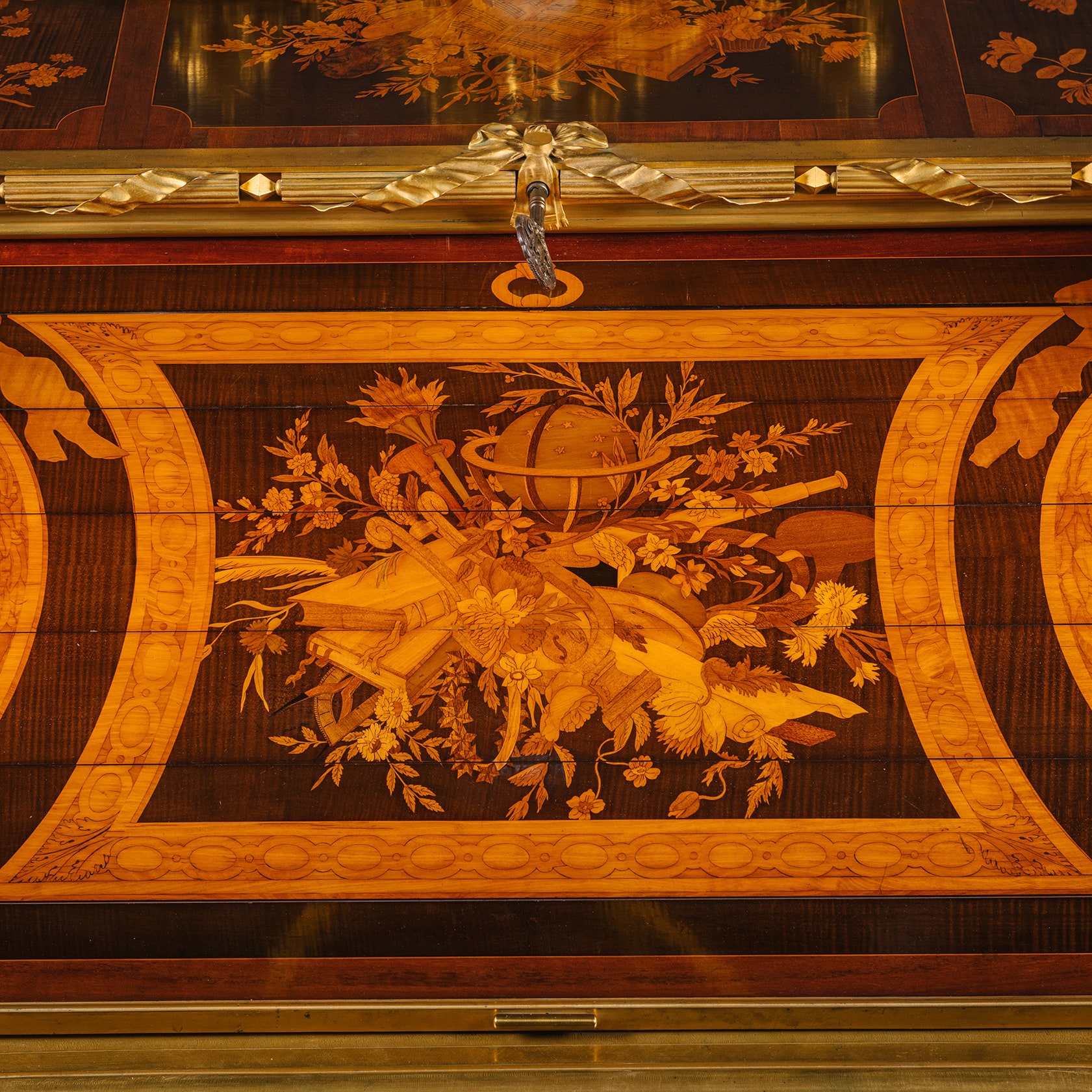
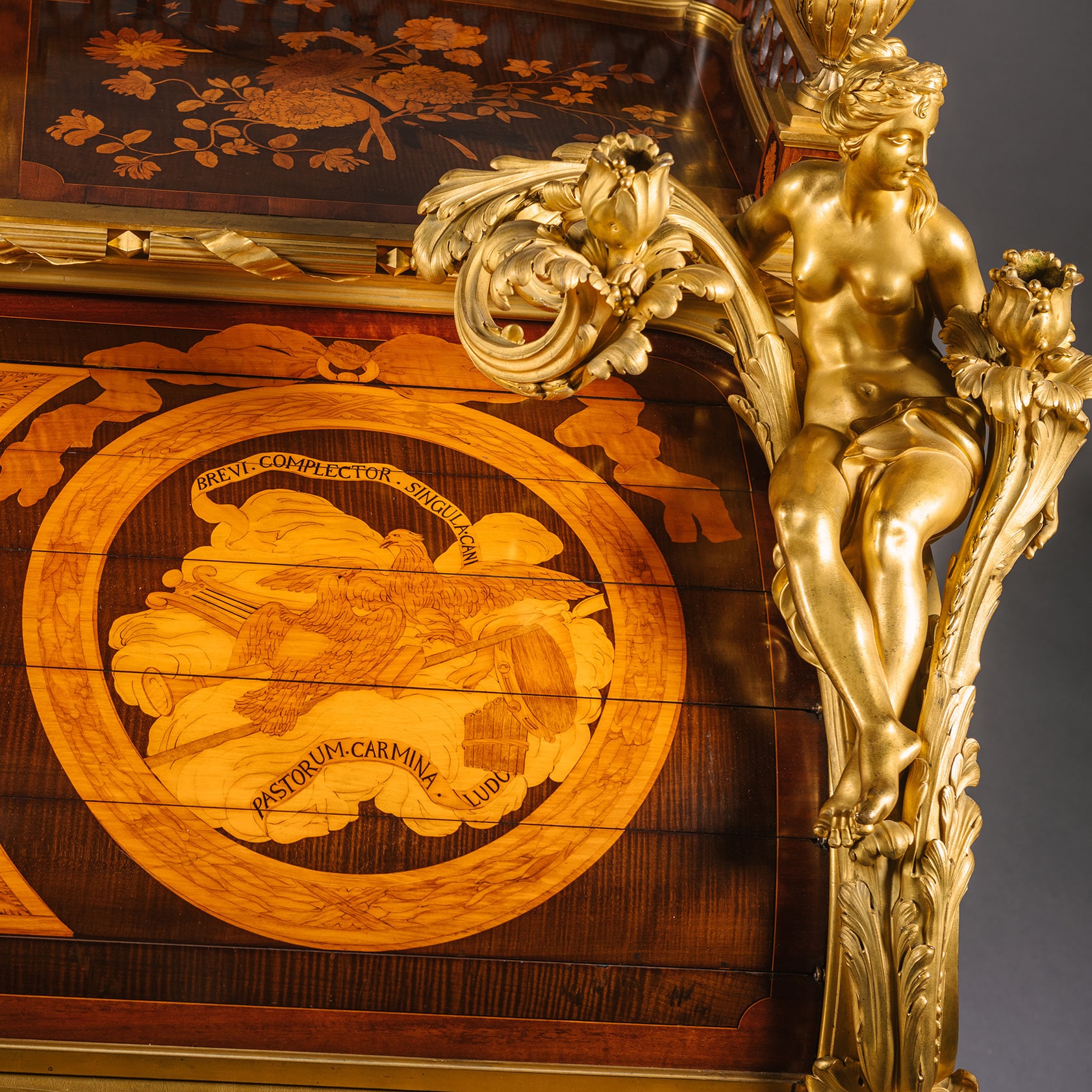
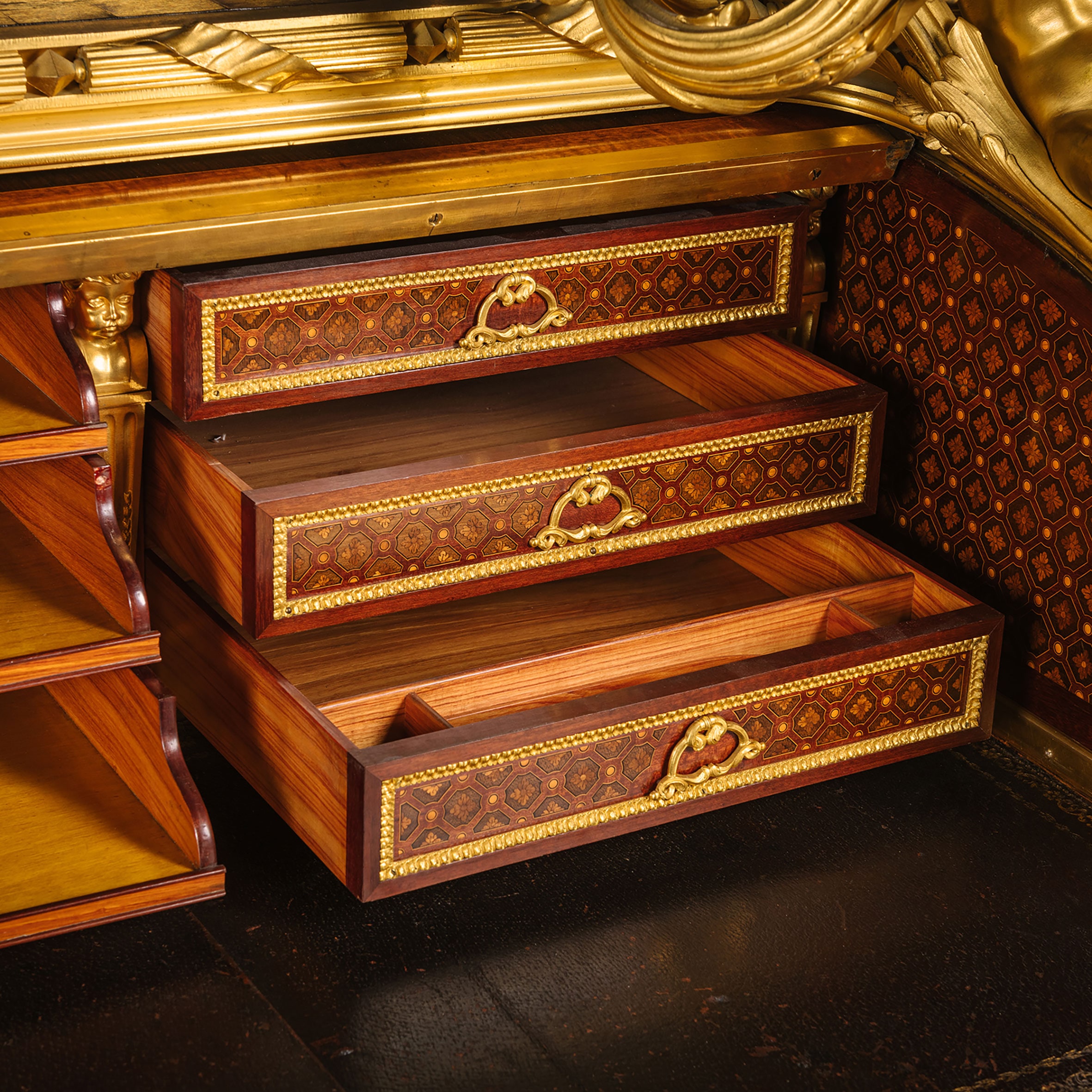

 Print
Print